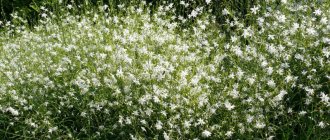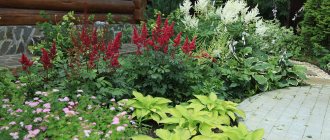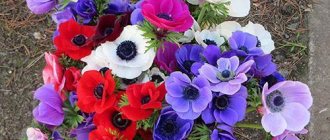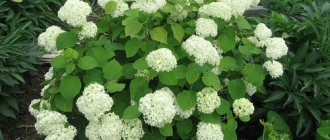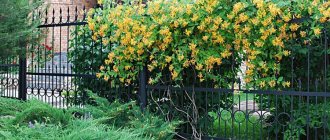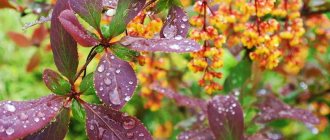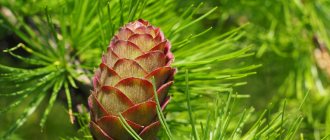Any summer resident dreams that his garden plot will be a blooming paradise, from early spring until the onset of frost.
Therefore, not a single flower bed is complete without annual flowers. The garden plot can be decorated differently every year, even in different colors. And annual crops help with this.
You can change the compositions every year, you just need to show your imagination. Let's consider which of the flowers are annual, which of them are undemanding to care.
↑ What to plant in a flowerbed of annuals
Annual plants have many benefits. Firstly, you will enjoy all the summer and autumn months, and you won’t have to worry about how they will survive the winter. Secondly, you can always plan where to plant flowers next year. Thirdly, after harvesting, for example, early plantings of greenery, you can plant annuals in this place, which will delight your eyes with their flowering until the fall.
You can also combine plants correctly and get an amazing flower bed, both in color and flowering time.
Among annuals there are many varieties and varieties that prefer only sunny places. But among the wide variety you can also find shade-loving plants that will decorate an area where no other crops want to take root.
Another advantage of annual flowers is that many are grown without seedlings. And the full growing season begins from the moment the seeds are sown until the end of flowering.
Annuals are “programmed” for rapid development, because they do not have time for long-term growth. They must, in one season: hatch from seeds, grow into a bush, bloom and, leaving a memory of themselves in beautiful photographs, become a thing of the past.
Just 10 years ago, flowers were grown in a flowerbed, which ones sprouted and which ones they liked. Now many people’s views on arranging a flower garden have changed. Today's flower beds are planted simply as works of art!
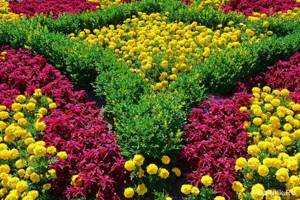
The flowerbed can be:
- different shapes: in the form of a triangle, rhombus, square, even an oval;
- mixed composition: perennial and annual flowers are planted with different flowering periods and different colors;
- consist of one or several tiers, be a vertical or elevated composition;
- consist of planted low-growing and tall-growing plants.
Low-growing flowers are often used to camouflage “bare” areas or among tall plants. The most popular among gardeners are the following low-growing plants: marigolds, nasturtium, petunia, zinnia.
↑ Marigolds Karina
Marigolds are classified as plants with a height of up to 15-20 cm; they do not have any special requirements for care. They prefer to grow in sunny areas, but even in partial shade the saturation of the petals will not change. The color of the flower is bright yellow or bright orange, with brownish splashes. Flowering is observed from June until frost. Marigolds are used to decorate borders, flower beds, and rockeries.

We recommend studying: a selection of the most beautiful annual garden flowers with photos
↑ Petunia
This annual beauty has a huge number of shades. Many varieties of petunia have been developed. There are flowers with both a bell shape and a variety of lush flower shapes. Petunia prefers to grow in a sunny area. Flowering occurs from mid-May until frost.
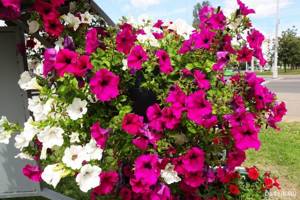
↑ Red salvia
This flower is also one of the unpretentious annuals. Combines harmoniously in flower beds with other flowering species. Several varieties have been developed with different colors. The inflorescence has the shape of a candle. Decorates the dacha plot with flowers all summer long.

↑ Calendula
This flower stands out among annuals for its decorative effect. Bright orange or yellow petals are collected in a basket. Grows in sun and partial shade. Flowering is abundant, from early summer to mid-autumn. The petals of the plant are widely used in medicine. Calendula not only decorates the garden, but also has medicinal qualities.
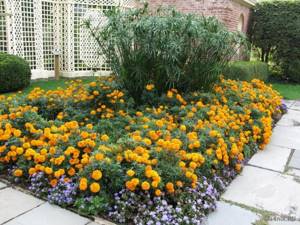
↑ Nasturtium
Many varieties and hybrids have been bred of this plant. Of course, the species with terry caps are beautiful. The planting site is suitable both on the sunny side and in the shade. You just need to take into account that in the shade there will be more greenery than inflorescences. Flowering lasts until early September.
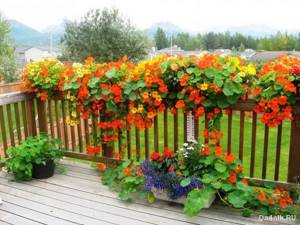
↑ Snapdragon
An annual plant with an attractive, unusual appearance. As the name implies, the shape of the flower resembles a pharynx. It blooms in the flowerbed all summer, delighting us with an abundance of flowers and colors. Looks very impressive in flower arrangements and in single plantings.

↑ Zinnia
Unpretentious annuals that bloom throughout the summer months, decorating any area. One short bush blooms for almost a month and a half. Low-growing and tall-growing varieties are planted in one place, which combine perfectly and create a beautiful composition. Varieties with different shades of petals have been bred. Planted in sunny places where there are no drafts.
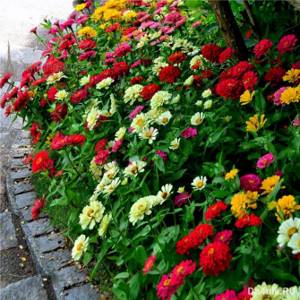
The main points when caring for low-growing flowers: stretching the stem and rapid growth of leaves, hiding the flowers. To prevent your flower garden from looking like a green meadow interspersed with flowers, follow these rules:
- do not overfeed plants with nitrogen, it is this microelement that gives leaves growth;
- when feeding, you need to buy fertilizers for flowering plants;
- the seeds should be sown at a short distance between them, then the grown bushes will not stretch out;
- Flowers for which shade is contraindicated cannot be planted in the shade.
Calendula (marigold)
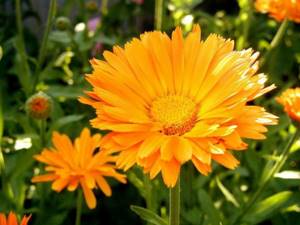
The well-known calendula is distinguished by its long and continuous flowering all summer long until frost. The medicinal properties of this plant have long been known to everyone. Therefore, many gardeners grow calendulas on their plots specifically for medicinal purposes. This plant can even be eaten. Its petals are added to salads or desserts. The plant can have several shades of yellow and orange.
Pros:
- Medicinal properties;
- Can be eaten;
- Unpretentious;
- Blooms until late autumn.
↑ Annual flowers up to 30-50 cm
↑ Dimorphothecium
Dimorphothecians resemble chamomile. An unpretentious plant, the color of the petals is pinkish, white, yellow and purple. The height of the bush is no more than 30 cm. The plant has strong immunity to pests and diseases. Flowering from June to October. The survivability of the flower allows it to be planted in any place in the summer cottage, except in the shade.
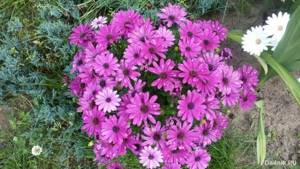
↑ Brachycoma
Brachycoma is an annual plant that grows in a dense bush. Grows on any soil, but on the sunny side of the site. The colors are bright pink and lilac. Flowering from mid-May to October.

↑ Dahlias
Dwarf varieties of annual dahlias look good on borders, in flower beds, and flowerpots. They are unpretentious plants that grow in the sun and in partial shade. Many different colors of dahlias have been developed.

↑ Balsam
Large inflorescences and bush height (up to 70 cm) distinguish this plant from other annuals. The flowers are double and semi-double, with snow-white and crimson petal colors. Impatiens blooms throughout the summer months.

↑ Malva annual
The annual beauty grows up to 1 meter in height. Mainly varieties with double flowers. Mallow is undemanding to soil and watering. It is advisable to plant on the sunny side.
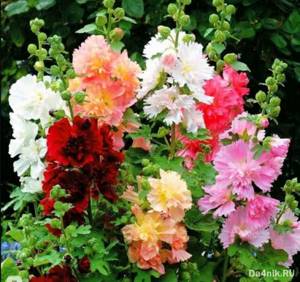
↑ Bell
Low-growing, up to 40-50 cm annual flower, with light blue bells. It can grow in sunny places and in partial shade. Bellflower is undemanding when growing.
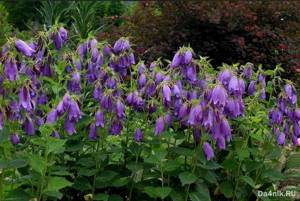
Care instructions
In dry weather, timely watering is important, but water should not get on the buds. Watering is best done in the evening or in the morning. It is necessary to loosen the soil in a timely manner, remove weeds, remove wilted flowers, otherwise the flowerbed will look untidy. Feed the plants 3-5 times a season. The soil is mulched , this will help retain moisture at the roots and prevent the growth of weeds.
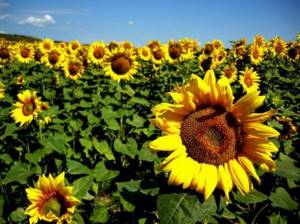
Annual ornamental plants will help create an excellent living garden, fill it with rich colors, and fit perfectly into many styles of landscape design.
Sources:
https://pion.guru/rasteniya/spisok-odnoletnih-rasteniy https://www.botanichka.ru/article/6-luchshih-odnoletnih-rasteniy-gigantov/ https://sotka.guru/kustarniki-i-travy /odnoletnie-rasteniya-spisok-odnoletnikov-posadka-i-uhod.html
↑ Annuals growing and blooming in the shade
Under bushes and spreading trees there is always a place below where you can plant flowers. There are only a few crops that want to grow in the shade. But among the annuals there are also those that bloom practically without exposure to sunlight.
↑ Cosmea
These plants grow quietly in semi-shady and shaded areas. Cosmos will create a holiday even in the shaded corners of the garden. Flowering is long and abundant. The shape of the flowers resembles a field chamomile. It is an unpretentious flower and does not require special care.
In dark areas you can create floral arrangements from balsam, cosmos and fuchsia.

↑ Brovalia
And this flower belongs to those crops for which the sun is contraindicated. And you need to plant brovalia in partial shade and shade.
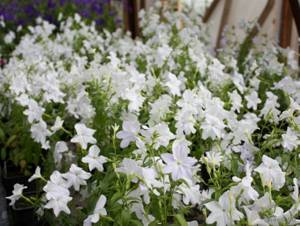
We recommend studying: planting and caring for morning glory in open ground - simple and effective tips
Godetia
Godetia flower belongs to the onagricaceae or fireweed family - an original, profusely flowering annual plant.
Her homeland is California. The fragile stem of godetia is densely covered with short, stiff hairs. The flowers of the plant are spade-shaped, white, pink or red.
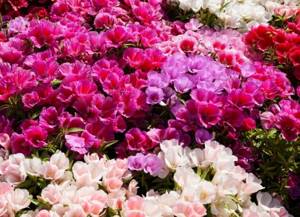
Godetia blooms for a long time. Its color fades when it blooms. Tall forms of godetia are decorative in bouquets, and low-growing ones are an excellent decoration for borders and flower beds.
Flowering and caring for godetia - video
Seeds are used to propagate godetia. The beginning of flowering is July-August. The plant is sun-loving, but does not tolerate too hot weather and prolonged rains.
↑ Climbing annual flowers
Climbing flowers, also called vines by summer residents, are always popular. Among the annual plants there are also climbing annuals. And they amaze with their beauty no less than perennials. Such plants are distinguished by their rapid development, low maintenance requirements and attractive appearance. Such flowers often decorate hedges, they are entwined with arbors, they become protection from wind and drafts for more delicate flowers.
↑ Morning glory
This flower has certain conditions for it to reach a length of 3 meters. It needs fertilizing, regular watering and a lot of sun. Otherwise, morning glory is unpretentious. It begins to bloom at the end of June, flowering continues until November.

↑ Nasturtium climbing
A variety of climbing beauty has also been developed. The plant reaches up to 3 meters in length.

↑ Tuebergia winged
The climbing plant blooms with large orange flowers. During the season it can grow up to 2 meters. Tuebergia is unpretentious in care and requires regular watering and a sunny place.

Plant diversity
People use many living organisms that live on earth. Our neighbors on the planet are green algae, mosses, higher spore plants, holosperms and angiosperms. Humanity needs all of these groups; they have industrial, agricultural, food, medical applications, and have educational and aesthetic significance.
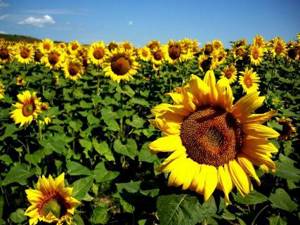
Among the representatives of the flora there are perennial, biennial and annual plants. Examples:
- Perennials: apple, peach, grape, lemon and other shrubs, vines and trees.
- Biennial plants: white cabbage, turnips, beets, carrots, tricolor violet.
- Annuals: tomato, pepper, balsam, wormwood, St. John's wort, chamomile, aster.
↑ What types of annuals are there?
When planning a flower bed or flower garden, take into account the flowering period of the selected plants, and also pay attention to what height they grow, how the leaves spread, what color the leaves and petals are.
↑ Division by flowering time
Spectacular compositions need to be created taking into account the time when flowering is most luxuriant. There are varieties in which flowers form throughout the summer. For example, zinnias, petunias, low-growing dahlias, calendula.
If plants are given regular sanitary pruning, they enter the second wave of flowering from August.
↑ Decorative deciduous annuals
Annual crops that do not bloom, but have very showy leaves, are considered:
- bright green kochia with lacy leaves;
- castor bean, which has large dark green or bright burgundy leaves;
- silvery cineraria;
- amaranth, which has green leaves and burgundy flowers.
Advice! Annual plants that have beautiful leaves are planted in the background of a flower garden or mixborder, because they will all rise above other flowers.
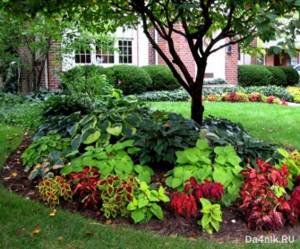
We recommend studying: what is the best way to sow Mallow seeds on your site?
Eschszolzia
The wormwood flower, eschscholzia, also called California poppy, belongs to the poppy family. He is from North America.
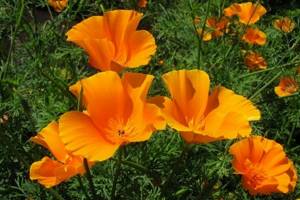
Eschscholzia is a very delicate plant with bright shiny flowers.
They are saucer-shaped, quite large, and can be simple or terry of various colors. The triply dissected leaves with long bluish-green petioles resemble the leaves of wormwood, for which they call Eschscholzia “wormwood”.
Growing and caring for Eschscholzia - video
The plant loves the sun. Flowers open under the influence of sunlight.
In the evening and when it is cloudy, the Eschscholzia flowers are closed. The flowers on the main shoot open first. Each flower blooms for four days, while the bush blooms for 1.5 months.
Eschscholzia flowers - photo
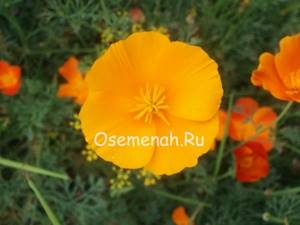
Eschscholzia is propagated by seeds in open ground, because it cannot withstand transplanting. The plant prefers dry sandy soils and sun. Eschscholzia is used in flower beds and ridges.


